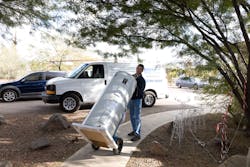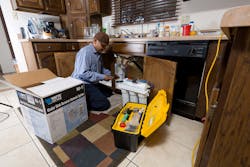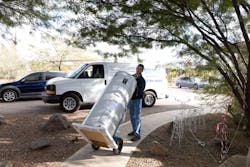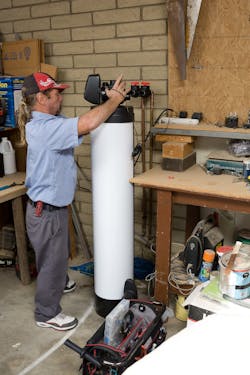At Aqua Science, it's all about natural resources
PHOENIX — Phoenix is known as the Valley of the Sun for good reason. Heat from the sun is so brutal in that desert bowl that it works overtime to pull all the moisture from air, streams and soil, making Phoenix the driest city in the thirstiest state.
And yet, the desert town once populated only by cacti, hardy reptiles and a band of cowboys has grown to more than 1.5 million people. Today, people and plants compete for the most precious commodity on earth — fresh water.
Water in Arizona is recharged at a painfully slow rate, no thanks to so little precipitation, just 7.66 inches a year. Also, groundwater replenishment suffers from rapid surface evaporation and the long distances water must travel through layers of parched soil to recharge deep aquifers.
The groundwater extracted from below Phoenix is generally of very poor quality. “Today, it’s what we in the water biz refer to as ‘extremely mineralized,’ with high concentrations of pollutants, minerals and calcium,” explained Derek Sajdak, vice president of Phoenix-based Aqua Science. The firm is a specialized plumbing company that knows a thing or two about improving water quality in a land so challenged by the elements.
The area’s groundwater conditions have made it necessary to pull 95% of domestic water from surface water sources such as the ever-shrinking Colorado River. The remaining water comes from groundwater. As an indication of the severity of conditions there, the EPA recommends all well owners in the state of Arizona have their water tested annually.
Focusing on need
Aqua Science specializes in reverse osmosis and other means of water filtration and treatment, solar thermal water heating and high-pressure mist cooling systems. According to Sajdak, they also do plumbing work when the need calls for it. Needless to say, their variety of work exposes them to all kinds of jobs in the area.
Recently, a horse ranch just five miles out of Phoenix called Aqua Science to install a solar thermal panel for domestic water heating and further water quality work at the ranch’s home. The driving force for the home improvement project was the owners’ decision that it was high time to take advantage of the blazing Arizona sun. “In a way, it was like we wanted to fight back,” they said. “The sun’s relentless around here, so this became our way of harnessing some of it.”
“It makes such good sense to install solar for domestic water heating. It’s sunny 360 days of the year, so why not use the sun to heat your water instead of paying a power company to do it?” said Steve Voldhart, solar specialist at Aqua Science. “Energy costs, the cost of credit and rebate incentives pretty much dictate the volume of solar business we do each year.”
In a bad year, Sajdak and Aqua Science may only install 50 solar thermal systems, while a year with good tax incentives has brought more than 200 installations. “The year 2012 was a wild ride,” added Sajdak. “We had two of our best months ever, and several of our worst. We’d definitely prefer the smoother, steadier ride.”
Solar thermal now
For Arizonians, incentives to install solar thermal arrays make the systems hard to resist. The result: calls day and night to price systems. Sometimes, said Sajdak, the callers don’t even ask. “They just want to know when we can put them in,” he added.
Current savings estimated for a typical residential installation range between $28-$45 per month (family of four).
“Today, to sweeten the deal, federal incentives pay for 30% of the costs of purchasing the products, and local power companies are paying about 45 cents/kilowatt hour for the equipment. The state offers an even $1,000. How could you not want to go solar?” said Sajdak.
Back at the ranch
Aqua Science found that one 4-ft.x10-ft. solar flat plate collector on the roof produced sufficient heat to meet the water heating needs at the ranch house, so service representatives Steve Barber and Noe Sanchez installed the collector where sun exposure was best.
They also installed an 80-gal. indirect Bradford White solar water heater in a hallway closet. Barber and Sanchez set it up so that the solar panel was the tank’s primary source of heat, easily maintaining the set-temp. An electric element drew energy only when water temperature was inadequate.
“I’ve been installing Bradford White water heaters going on 20 years now. They’re the product of choice for applications in the area. Our local supplier, Ferguson Enterprises, always makes sure they’re available at the drop of a hat,” said Volhardt.
Aqua Science prefers to install drainback-style solar thermal systems. The key advantage is that freeze protection is a non-issue. Also, if grid power fails, heat transfer fluids degrade or won’t overheat and “steam-off.”
With a drainback system, a heat exchanger connects the water heater to the cold water supply, recirculating warm water back into the home. A drainback system’s freeze protection comes from its design: when the sun goes down, water simply returns to an expansion tank inside the home. The panel is empty.
Two Taco pumps are built onto the heat exchanger. A Taco 006 recirculates water around the water heater into the exchanger while a Taco 009 recirculates water from the heat exchanger up into the panel and falls back down.
“We buy Integrated Solar pump stations, which come with Taco circulators,” said Sajdak. “Their cartridge style pumps are like no other; once they reach their life expectancy, we simply replace the cartridge. Removing four bolts is all it takes to access the old cartridge and then to slip in a replacement.”
At the rural ranch house, the owners also requested a reverse osmosis system to improve the quality of water they were pulling out of the ground. Their well was 400-ft. deep and they’d noticed that, especially during the past several months, the quality had deteriorated steadily.
“We first noticed the change in taste,” they said. “It was a metallic taste that finally led us to have Aqua Science test the water for us. The results came back with bad news: there were substances we can’t pronounce and high nitrates. The Aqua Science technician assured us that a new RO system would more than adequately purify the water.”
After completing hook-ups for the solar panel and water heater, Barber and Sanchez then went into the kitchen where they installed a Watts Pure Water zero-waste RO system.
“All RO systems reject about nine-tenths of the water they take in, pushing it through a series of filters, and finally the reverse osmosis membrane,” explained Sajdak. “Only the Watts zero-waste unit circulates the rejected water back into the domestic water system’s hot water side. All other RO units waste the water, pitching it down the drain — which can mean that homeowners who tap municipal water supplies pay plenty for the water, then pay to get rid of it, too. At least with a zero-waste system, there’s no waste, not even a drop.
“People in Arizona drink a lot of bottled water. When they learn that most bottled water sold today is prepared by reverse osmosis systems — it just clicks,” added Sajdak. “It makes sense to many of the homeowners we speak with that they can so easily have that same type of water accessible from their own kitchen sink — regardless of the source.
“RO systems are pretty much a steady market,” continued Sajdak. “We install anywhere between 500 to 1,000 Watts Reverse Osmosis systems a year. Because it’s such a reliable product and they are easy to install, they’re big business for us.”
At the ranch home, the Watts RO unit was installed under the kitchen sink. “Watts systems have three connections: the cold water supply connection, which taps into the cold water supply and takes that water to the RO unit. Also, the drain line connection, and the faucet connection,” explained Sajdak.
“We’ve found that 50-80-PSI is sufficient pressure for RO systems to produce purified water,” added Volhardt. “The system we installed at the ranch house produced around 25 gallons of purified water a day.”
As it turned out, the horse ranch near Phoenix was a textbook case in demonstrating how a skilled contracting firm, when applying reliable technology, can team up with Mother Nature for solutions even she’d approve of.



